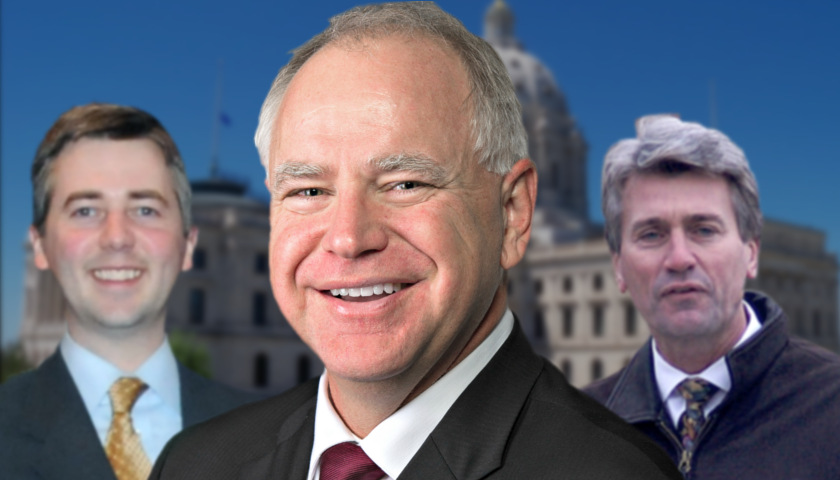The Partnership for a New American Economy (PNAE), is a powerful and well-funded big-business-cheap-labor lobby led by business leaders, former politicians, and chambers of commerce. Renamed to the shortened New American Economy (NAE), the coalition continues its push for comprehensive immigration reform by highlighting the work ethic and perceived business ambitions of legal and illegal immigrants over native-born Americans.
Don Ness, former Democrat mayor of Duluth and R.T. Rybak, also a Democrat and former mayor of Minneapolis, are named members of the NAE. During Rybak’s twelve years as mayor over 11,000 refugees were brought to Minneapolis by federal resettlement contractors and he was openly critical of Arizona’s legislative efforts to curb illegal immigration.
Included in NAE’s “15 key economic issues of immigration reform in America” which promote legal and illegal immigration are:
• Supporting legal status for the 11.4 million undocumented immigrants which PNAE says pay taxes and do the jobs American citizens won’t do, and despite being in the country illegally, “even start their own businesses.” In a 2014 Wall Street Journal oped, NAE co-founder Rupert Murdoch said that illegal immigrants who are already here should be provided a path to citizenship.
• Supporting resettlement of refugees who NAE says that after living in the U.S. between 16-25 years are earning well above the income of refugees who have been here for five years or less. Moreover, NAE believes refugees are the answer to reviving aging and declining communities.
• Pushing state and local policymakers to support in-state college tuition for illegal immigrant students.
Founded in 2010, the NAE formed to convince the public and policymakers that comprehensive immigration reform like the 2013 “Gang of Eight” amnesty bill which offered a path to citizenship for illegal aliens in the U.S., would also help grow the economy and create jobs for Americans. The amnesty bill also made it easier for cities to refuse cooperation with ICE and continue sanctuary city policies.
After Congress failed to pass the “Gang of Eight” bill, NAE turned its focus to influencing the politics of immigration at the state and local level by collaborating with Welcoming America to use incentives like “Gateways for Growth” (G4G) grants.
Welcoming America which provides technical assistance to G4G recipient cities, was launched in 2009, with support from George Soros’ Open Society Foundation’s Four Freedoms Fund.
The G4G payouts are designed to “integrate immigrants as part of an economic growth strategy.” In keeping with open borders groups, no distinctions are made between legal immigrants and illegal aliens.
No Minnesota cities made the first round of G4G awards likely because state and local leadership have already laid a foundation for welcoming legal immigrants and shielding illegal aliens in the state.
In 2013, for example, the Minnesota legislature passed its own “DREAM Act” providing state-funded benefits to illegal aliens such as the reduced in-state college tuition and access to state financial aid. Minneapolis is now contemplating providing illegal aliens a municipal ID card which will help them pass as legal residents.
As to refugees, the state annually receives between 1,600 to 2,600 primary refugees who enter as legal immigrants. The numbers do not, however, account for secondary migrants who are first resettled in other states but then relocate to follow friends, relatives or jobs.
The refugee resettlement industry has helped create Minneapolis’ segregated “Little Mogadishu” enclave and has also, as reported by the Twin Cities Pioneer Press, helped make Minnesota the state with the highest number of refugees per capita:
Minnesota has the highest number of refugees per capita nationwide, according to the U.S. Census and refugee-support agencies. With 2 percent of the nation’s population, Minnesota has 13 percent of its refugees.
Even though Minneapolis and Winona have not received a G4G grant to date, they have joined the Welcoming Cities and Counties (WCC) initiative which was launched with a $2.66 million dollar grant from the Clinton Foundation.
The WCC program is intended to “create more inclusive and immigrant-friendly communities, maximize opportunities for economic growth, and position themselves as competitive in the global economy.”
Having already joined the Welcoming Cities program, Austin was included in the second cycle of G4G grant awards and has adopted a strategic “welcoming plan” to prioritize the needs of immigrants because of their perceived economic value. With Hormel Foods headquartered in Austin and the city’s “Vision 2020” dominated by Hormel representatives, the city is a fertile target for the NAE and Welcoming America agenda.
Hormel, like other meatpacking companies, relies heavily on refugee labor. In fact, it was Hormel’s Jennie-O turkey processing plant that brought the first Somali refugees to Faribault:
Hundreds of Somali refugees eventually flocked to Faribault for jobs the company had been struggling to fill after it had eliminated union positions and lowered employee wages.
The arrival of refugee groups, in particular those who arrive with few skills and little to no English language, often end up working for “big meat” as was the case in places like Wilmar and Pelican Rapids where other Jennie-O plants are located.
Welcoming America’s 10-state region “Welcoming Economies Global Network (WE Global),” is another initiative focused on immigrant economic development Minnesota.
NAE has used the WE Global umbrella to network anyone in Chamber of Commerce leadership who commits to globalization and developing the immigrant workforce as priorities.
Since 2002, the earliest date from which U.S. State Department data on the arrival of refugees is available, Minnesota has received 42,221 refugees which includes large numbers of Somalis, Laotians, Burmese and Ethiopians. The numbers do not, however, account for secondary migrants.
Of the 172,378 total U.S. primary Burmese refugee arrivals to date, over 82,000 have been in the 21 to 50 year old working age group with no English language skills and with mostly primary and secondary school education. The number of Burmese refugees aged 65 and older who most often receive Social Security benefits is reported at 2,143.
Data from FY2003 forward reports 8,413 Burmese, mostly the ethnic Karen, have been resettled in Minnesota. Early on many settled in St. Paul but commuted to Austin to work at Quality Pork Processors plant. While St. Paul is reputed to have the largest Karen Burmese community in the U.S., more Burmese families are settling in places like Austin and Marshall instead to be closer to the meat processing plants.
In 2003, a group of volunteers organized the Karen Community of Minnesota to lead their community and offer assistance to arriving Karen refugees. Six years later with state and federal money, paid staff the Karen Organization of Minnesota (KOM) opened in St. Paul. In 2014, KOM opened a branch office in Marshall.
Somalis are the largest group to be resettled in Minnesota. Of the total 103,765 primary Somali refugee arrivals to the U.S., 16,603 have been sent to Minnesota. Demographic data for total U.S. Somalis arrivals put 38 percent, or approximately 39,189 of arrivals in the 21 to 50 year old group. An almost equal number, or 37,023 Somali arrivals, were reported as under 14 years of age and 1,814 were reported to be aged 65 or older.
Of the total number of Somalis that arrived nationwide, 29% were reported to have no education.
Somalis in Minnesota have also established their own ethnic-specific organizations catering to the needs of the large African community in the state. For example, the African Development Center, Minnesota offers low-skilled Africans jobs that do not require knowing English:
According to a recent report by The Minneapolis Foundation, 13 percent of Minnesota’s foreign born residents in the 2000 Census were from Africa – a higher percentage than in any other US state. Most Africans have come to Minnesota over the past generation as refugees fleeing civil strife in Somalia, Liberia and the Sudan. Other relatively large African populations recently arrived include Nigerians, Ethiopians, and Eritreans. This influx will likely continue. Minnesota offers immigrants an established African population, a strong economy, a good quality of life, educational opportunities, and unskilled jobs that don’t require fluency or literacy in English.
NAE’s August 2016, Minnesota state report admits that the foreign-born are “much more likely to be working-age than the U.S.- born” and “because they tended to be working-age, immigrants were 24% more likely to work than native-born Minnesotans.” The NAE report defines “working-age” as ranging in age from 25 to 64.
Foreign-born residents make up more than two out of every five employees in the state’s animal slaughtering and processing industry. They also account for 23.9 percent of the state’s workers in computer systems design and related services, which contributed $4.6 billion to Minnesota’s Gross Domestic Product (GDP) in 2014. Immigrants also frequently gravitate toward sectors where employers may struggle to find enough interested U.S.-born workers. Immigrants in Minnesota, for instance, make up 23.6 percent of workers in services to buildings and dwellings, an industry that includes exterminators and office cleaning staff.
In recent decades, immigrants have also played an important role in Minnesota’s manufacturing industry.
NAE also estimates that 92,924 illegal aliens are living in Minnesota and that illegal aliens are working in jobs such as food service, waste management, agriculture, manufacturing and construction.
NAE insists that increasing cheap labor pools through immigration is necessary for the revival of economically depressed rural communities and also insists that legal immigrants like refugees and illegal aliens are doing the jobs Americans won’t do.
A recent study released by the Center for Immigration Studies, however, disputes NAE’s justification for expanding the immigrant workforce. Findings of the CIS study include:
- Of the 474 civilian occupations, only six are majority immigrant (legal and illegal). These six occupations account for 1 percent of the total U.S. workforce. Moreover, native-born Americans still comprise 46 percent of workers in these occupations.
- Many occupations often thought to be worked overwhelmingly by immigrants (legal and illegal) are in fact majority native-born:
o Maids and housekeepers: 51 percent native-born
o Taxi drivers and chauffeurs: 54 percent native-born
o Butchers and meat processors: 64 percent native-born
o Grounds maintenance workers: 66 percent native-born o Construction laborers: 65 percent native-born
o Janitors: 73 percent native-born
- High-immigrant occupations (25 percent or more immigrant) are primarily, but not exclusively, lower-wage jobs that require relatively little formal education.
- In high-immigrant occupations, 54 percent of the natives in those occupations have no education beyond high school, compared to 30 percent of the rest of the labor force.
Harvard professor of economics and social policy, George Borjas explains that the wages of “low-skilled American workers, including many blacks and Hispanics” are most negatively impacted by the inflow of immigrants, “a disproportionate percentage [of whom] have few skills,” and that “[a]ccording to census data, immigrants admitted in the past two decades lacking a high school diploma have increased the size of the low-skilled workforce by roughly 25 percent.”
NAE and Welcoming America’s prioritization of the legal and illegal immigrant workforce does not acknowledge employment competition posed by low-skill immigrants.




